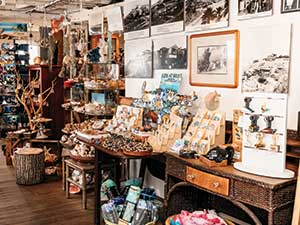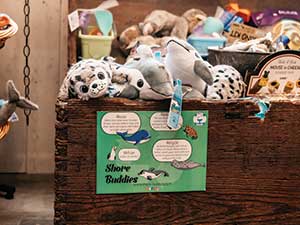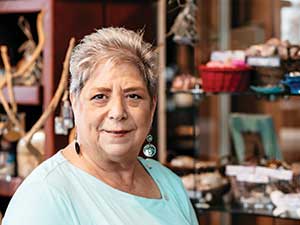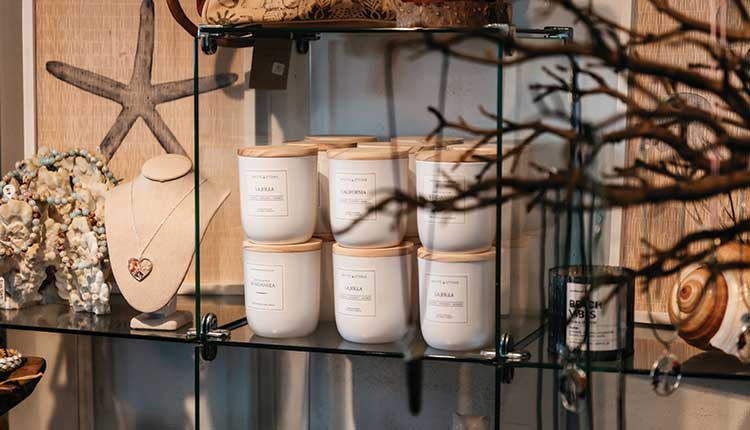The Cave Store in La Jolla, California, has been inviting paying customers to peak below the surface since 1903.
Rumor has it that L. Frank Baum once visited in the 1930s. When “The Wizard of Oz” writer descended the tunnel that took two Chinese immigrants five months to chisel with a pick ax and a shovel, he marveled how the cave silhouette resembled Sunny Jim, a cereal mascot used to sell Wheat Flakes.
“The silhouette was really very similar,” says Patrice Forrister, the buyer for the Cave Store. “But in the 80s, the rock fell and formed [more of] a chin, but before, he really looked like Sunny Jim. And that’s how he got his name.”
On the side of a cliff overlooking the Pacific Ocean, a wood-shingled building houses a 1,200-square-foot gift shop known as The Cave Store.
Welcome to the longest-running store in La Jolla, California. Oh, and by the way — it’s the entrance to a sea cave that was reportedly used by bootleggers and smugglers. More on that later.
Made For Merchandising The Cave Store is more than the final destination to collect souvenirs and gifts before heading home — it’s the destination. And with a history as storied and unique as this, the souvenirs had better be, too.
“We try to get very unique shells, or at least I try to get statement pieces. I do have a girl that works on the shells since I can’t do that, too,” Forrister admits. “You know, like a large blue coral or something.”
The San Diego County resident, who has had her hand in retail for nearly 40 years, worked in legendary stores such Saks Fifth Avenue and the now-defunct Silver Skillet, and intuitively knows a good buy when she sees one.
“I price everything realistically,” she notes. “I’ve got a history long enough to know what things are worth.
 Displays on antiques and historic photos make an ideal presentation at The Cave Store. Among the typical magnets, candles, keychains, stickers, shot glasses, crystals, sun catchers, coastal-themed decor, abalone, clothing, postcards, and jewelry, 300 to 600 customers pass through the doors daily to lay claim to more sought-after finds. Items like wooden praying Buddha cats and dogs, essential oils, geodes, kimonos, hand-drawn stickers, dried flower earrings and pieces from Guatemala are the more unique souvenirs that Forrister really prides herself on.
“I try to find companies that give back and donate money to research,” she says. “And we love name-drop items.”
Given these two prerequisites for space in the gift shop, Forrister houses products from Life at Sea, which donates a portion of every sale to ocean and environmental conservation while Shore Buddies “makes stuffed animals from recycled plastic bottles and donates $1 from every product purchase to save marine life,” according to the company’s website.
“Then we have geodes, and all sorts of rocks and crystals, and that is really amazing because two of the girls here know all about the crystals, what you should put in your purse, [et cetera],” she muses.
And for new-age and metaphysical product designers, Forrister turns to Benjamin International. “That’s a company that has all sorts of interesting little things,” she says.
Show And Tell But it’s not just the items for sale that Forrister believes captivates customers. Displaying the merchandise is just as important as showcasing relics and artifacts that tell the story that visitors come to see.
 Plush from Shore Buddies peak from a treasure chest for maximum cuteness. “I just try to make sure that [the displays are] aesthetically pleasing. You don’t want a whole bunch of ducks in a row,” she advises. “You want people to come in and see the items and say, ‘wow, I really need that.’ And good-looking displays make a huge difference. They really do.”
Forrister adds that tantalizing displays alone won’t always make merchandise sell. Sometimes it takes a little extra help from unique settings and/or props.
“We have a very eclectic mix of furniture and a lot of beautiful antiques that we use as displays,” she notes “It’s very unconventional.”
Sure, there are glass shelves, baskets and cubes to hold shells; the geodes and crystals glisten on a glass rounder sectioned off like a pie. But then there’s a big, old treasure chest for the children’s items like the Shore Buddies, a helmet with barnacles that pays homage to the sea cave hiding below the gift shop, and the wall of fame — black and white photos that serve as a focal point for the legend that begins with 145 steps down.
A Storied Past As the story goes, in 1902, a German artist named Gustave Schultz hired immigrants to mine a tunnel from The Cave Store — Schultz’s original residence — down through the sandstone cliffs of La Jolla Cove and into Sunny Jim’s Sea Cave, according to the gift shop website.
At the time, he charged only 50 cents per guest compared to the current rate of $10 for adults and $6 for children. And the rope that originally led thrill seekers to the cave was replaced by the stairs much later, but the stories that make the gift shop a destination remain the same.
“It’s been said that during Prohibition, bootleggers smuggled alcohol and opium into San Diego through the sea cave by carrying it through this tunnel,” the website explains.
Gift shop visitors can take the long, slippery flight of stairs to a wooden viewing platform in the hopes of glimpsing sea lions basking on the rocks or seals splashing about.
Friendly Faces Among the 15 employees milling about in the gift shop every day is Tim Gonzales who runs “the line” of guests waiting to descend into the sea cave.
“Tim, he’s our sole guy, he’s been here for 16 years,” Forrister notes of her colleague. “He knows everything about the cave. He’s been a local for a long time.” She describes him as a mild-mannered, fabulous man with long, gray hair and “a sweetheart.”
Unofficially, Gonzales is the soothing voice that calms patrons while they wait in line in the California heat to take the plunge into the cave. He reads the safety waiver, takes guests’ names and directs them to the stairs to begin the march down the lighted path to the cave.
“We can’t send a whole bunch of people down there at once,” Forrister explains. “If two come up, we get to send two down. So that’s how that works. And that can be very ... people can get kind of [impatient], but they’re told to come back and shop.”
Artistic Finds Among the top-selling according to Forrister are the handmade treasures and most notably — the jewelry selection.
“We do really well with our jewelry. We have two girls that also make jewelry for the owner and [people] get excited because they’re one-of-a-kind pieces,” she notes. “We have another girl that works here that actually draws and we have her [make] stickers. We try to promote the artistic people we have.”
Forrister says she also tries to support and buy local and in-state with SF Mercantile, with the “SF” being short for “San Francisco.” The company promotes “products that celebrate the vibrant and diverse culture that is unique to California and designed by artists who live here, in the Golden State,” according to the website.
A Debt Of Gratitude  After 40 years in retail, Patrice Forrister has a pulse on what to buy. Forrister credits the owner, Shannon Smith, for allowing her to use creative freedom in creating displays and other showstoppers for the last 15 years. Smith took over as owner after her husband, Jim, passed away.
“I love the fact that I can be creative and that I work with a great bunch of girls, and the owner lets me express things and lets me visually go the way I want,” Forrister notes. “She’s very open to products that I buy.”
Forrister adds that she’s proud of the work that she’s done in “bringing in new products and figuring out what the people want and what they want to fly home with,” but she’s even happier to see locals buying and shopping in the gift shop.
“You know, it’s just such a great place,” she admits. “I’m really, really lucky that I landed here.”
|




